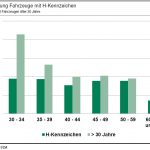
(English below)
Die Altersstatistik des Kraftfahrt-Bundesamt zu H-Kennzeichen resultierte in folgender Pressemitteilung des VDA (Verband der dt. Automobilindustrie):
Im Jahr 2017 blieb der Anteil von Fahrzeugen mit H-Kennzeichen, die ein Alter zwischen 30 und 39 Jahren haben, mit 39,3 Prozent im Vergleich zu den über 40 Jahre alten Fahrzeugen konstant. Alle Befürchtungen, dass gerade eine zunehmende Anzahl „neuer“ Oldtimer zu einer Schwemme von historischen Fahrzeugen führen könnte, finden somit keine Bestätigung.
Die Zahlen sind der jährlichen Information des Kraftfahrt-Bundesamt (KBA) zu Fahrzeugzulassungen zu entnehmen. Der KBA-Bericht veröffentlicht jährlich die Altersstatistik aller zugelassenen Fahrzeuge mit H-Kennzeichen. Diese Kennzeichen können nur Fahrzeuge erhalten, die mindestens 30 Jahre alt sind und sich im originalen, technisch einwandfreien Zustand befinden. Der Verband der Automobilindustrie (VDA) wertet diese Statistik in regelmäßigen Abständen aus, um rechtzeitig Trends bezüglich der Entwicklung von Oldtimern zu identifizieren.
Zum 01.01.2018 befanden sich von insgesamt 477.000 Fahrzeugen mit H-Kennzeichen 187.000 im Alter zwischen 30 und 39 Jahren. Das entspricht einer Steigerung gegenüber dem Vorjahr von 11 Prozent. Ähnlich verlief die Entwicklung der Fahrzeuge älter als 40 Jahre mit einer Zunahme von 10,8 Prozent.
Dabei fällt auf, dass lediglich 44 Prozent aller Fahrzeuge zwischen 30 und 34 Jahren mit einem H-Kennzeichen ausgestattet sind. Das ist ein deutliches Zeichen, dass bei weitem nicht jedes Fahrzeug automatisch mit dem Erreichen der Altersgrenze das den echten Oldtimern vorbehaltene Kennzeichen erhält. Vor 10 Jahren stellte sich die Zusammenstellung der unterschiedlichen Altersgruppen noch ganz anders dar. Zum 01.01.2008 betrug der Anteil der Oldtimer im Alter von 30 – 39 Jahren noch 53,5 Prozent, zum 01.01.2018 waren es gerade noch 39,3 Prozent.
Der Fachbereich Historische Fahrzeuge des Verband der Automobilindustrie (VDA) ist eine zentrale Servicestelle für seine Mitglieder in Sachen Oldtimer. Er ist zuständig für die Erarbeitung von Positionsbestimmungen bei politischen, rechtlichen und wirtschaftlichen Fragen und vertritt die Automobilindustrie in den relevanten Gremien und bei den zuständigen Behörden, damit Oldtimer auch künftig problemlos auf öffentlichen Straßen
fahren können.
Wir danken dem VDA für die Überlassung der Informationen.
Germany: no major change in age statistics for historic vehicles
The latest vehicle age statistics of the German Federal Motor Transport Authority on so-called “H-plates” (number plates for historic vehicles, type “…-… H”) resulted in the following press release of the VDA (Association of the German Automotive Industry):
In 2017, the proportion of H-plate labelled vehicles between 30 and 39 years of age remained constant at 39,3 percent, compared to vehicles over 40 years of age. All fears that an increasing number of “new” classic cars could lead to a flood of historical vehicles are therefore not confirmed.
The figures can be found in the annual vehicle registration information published by the German Federal Motor Transport Authority (Kraftfahrtbundesamt, KBA). The KBA report publishes annual age statistics for all registered vehicles with H-plates. These plates can only be obtained for vehicles that are at least 30 years old and in their original, technically perfect condition. The German Association of the Automotive Industry (Verband der deutschen Automobilindustrie, VDA) evaluates these statistics at regular intervals in order to identify trends in the development of classic cars in good time.
As of 01-Jan-2018, 187.000 of a total of 477.000 vehicles with H-plates were between the ages of 30 and 39 years. This corresponds to an increase of 11 percent over the previous year. The development of vehicles older than 40 years was similar, with an increase of 10,8 percent.
It is striking that only 44 percent of all vehicles between the ages of 30 and 34 are equipped with an H-number plate. This is a clear sign that by no means every vehicle automatically receives the registration plate reserved for real classic cars when it reaches the age limit. Ten years ago, the composition of the different age groups was quite different. As of January 1 2008, the share of classic cars aged 30 – 39 still amounted to 53.5 percent, as of January 1 2018 it was just 39.3 percent.
The Department of Historic Vehicles of the German Association of the Automotive Industry (VDA) is a central service point for its members in matters of classic cars. He is responsible for drawing up position statements on political, legal and economic issues and represents the automotive industry in the relevant bodies and with the responsible authorities so that classic cars can continue to be driven on public roads without problems in the future to drive the car.
The Amicale would like to thank the VDA for providing the information to us – and you.
